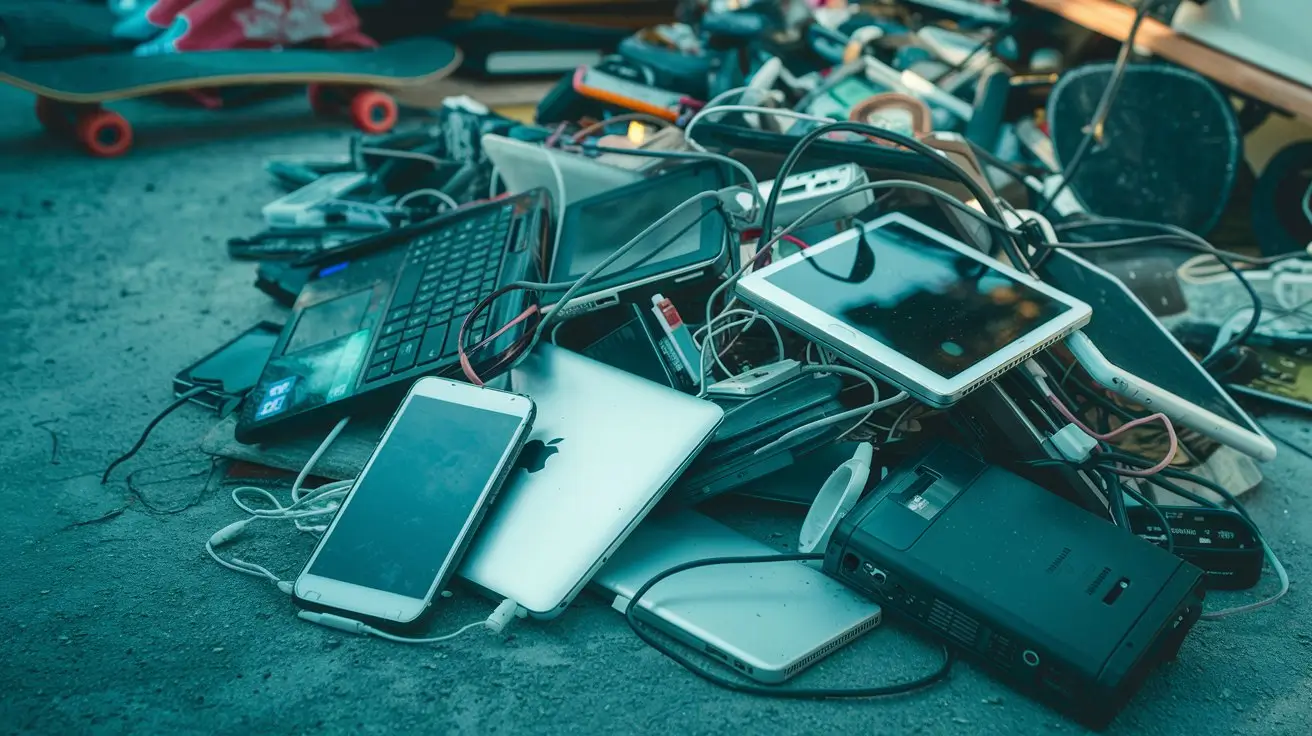E-Waste Awareness
Electronic waste or e-waste is a growing global concern. Refurbishment plays a vital role in reducing the environmental impact of e-waste by increasing the life of electronic devices and reducing the demand for new production.

What is E-Waste?
E-waste includes any electronic device that has reached the end of its useful life. Common e-waste examples include:
- Outdated computers and laptops
- Smartphones and tablets
- Printers and scanners
- Television sets
- Gaming consoles
- Electronic accessories and chargers
The Impact of E-Waste
Every year, millions of electronic devices end up in landfills. Understanding proper e-waste management is crucial because:

- Electronic devices contain hazardous materials like lead, mercury, and cadmium
- Improper disposal can contaminate soil and water sources
- Valuable materials that could be recycled are lost
- Manufacturing new devices increases carbon footprint
How Fixswift Promotes E-Waste Reduction
At Fixswift, we’re committed to sustainable e-waste management projects through:
- Professional device refurbishment
- Extended product lifecycles
- Responsible parts recycling
- Consumer education
- Proper disposal practices
E-Waste Recycling: Making a Difference
Proper e-waste recycling involves several steps:
- Collection of old devices
- Assessment of reusability
- Data wiping and security
- Parts harvesting
- Material recovery
- Environmental disposal
Finding E-Waste Solutions Near You
Looking for e-waste disposal options? Here’s how to responsibly manage your old electronics:
E-Waste Store and Collection Centers
- Drop off at certified collection points
- Schedule pickup services
- Participate in recycling events
- Visit authorized e-waste near me locations
Benefits of Proper E-Waste Management
- Environmental Protection
- Reduces landfill waste
- Prevents toxic material leakage
- Conserves natural resources
- Economic Benefits
- Creates green jobs
- Recovers valuable materials
- Reduces production costs
- Social Impact
- Improves public health
- Supports sustainable development
- Promotes responsible consumption
Take Action Today
Help reduce e-waste by:
- Choosing refurbished devices
- Extending device lifespan through proper maintenance
- Donating working electronics
- Recycling through authorized centers
- Spreading awareness about e-waste impact
Resources and Guidelines
For detailed information about e-waste management standards and procedures, download our comprehensive e-waste management PDF guide, which includes:
- Best practices for disposal
- Recycling center locations
- Environmental impact data
- Legal requirements
- Step-by-step disposal guide
Together, we can make a difference in reducing e-waste and protecting our environment for future generations.
Why is E-Waste Management Important?
E-waste management is crucial for several reasons:
- Environmental Protection: Proper e-waste management helps prevent harmful substances like lead, mercury, and cadmium from contaminating soil and water, thereby protecting the environment.
- Resource Conservation: Recycling e-waste allows for the recovery of valuable materials such as gold, silver, and copper, reducing the need for mining and conserving natural resources.
- Health and Safety: Improper disposal of e-waste can lead to the release of toxic chemicals, posing serious health risks to humans and wildlife. Effective e-waste management ensures these hazardous materials are handled safely.
- Legal Compliance: Adhering to e-waste management regulations helps companies avoid legal penalties and demonstrates corporate responsibility.
- Economic Benefits: Recycling and refurbishing e-waste can create job opportunities and contribute to the economy by providing raw materials for new products.
How can I Dispose of My Old Electronic Devices Responsibly?
Disposing of old electronic devices responsibly is essential for protecting the environment and ensuring the safe handling of e-waste. Here are some steps you can take:
- Use Authorized Collection Centers: Drop off your old electronic devices at authorized e-waste collection centers or take-back points set up by manufacturers and retailers.
- Participate in Take-Back Programs: Many electronics manufacturers and retailers offer take-back programs where you can return your old devices for proper recycling.
- Donate or Sell: If your electronic devices are still functional, consider donating them to charities or selling them to someone who can use them. This extends the life of the product and reduces e-waste.
- Recycling Events: Look for local e-waste recycling events organized by community groups or municipal authorities. These events provide a convenient way to dispose of your e-waste responsibly.
- Certified E-Waste Recyclers: Ensure that your e-waste is handled by certified recyclers who follow environmentally sound practices. This ensures that hazardous materials are safely managed and valuable resources are recovered.
By following these steps, you can help reduce the environmental impact of e-waste and contribute to a more sustainable future.
Are E-Waste Management Services Expensive?
The cost of e-waste management services can vary depending on several factors, but here are some key points to consider:
- Service Type: The cost can depend on whether you are using basic collection services, comprehensive recycling, or specialized disposal services for hazardous materials.
- Volume of E-Waste: Larger volumes of e-waste may incur higher costs due to the need for more extensive handling and processing.
- Location: Costs can vary based on your location and the availability of local e-waste management facilities. Urban areas may have more options and competitive pricing compared to rural areas.
- Regulatory Compliance: Ensuring compliance with environmental regulations can add to the cost, but it is essential for legal and ethical reasons.
- Long-Term Savings: Investing in proper e-waste management can lead to long-term savings by avoiding potential fines for non-compliance and reducing environmental cleanup costs.
While there may be some costs associated with e-waste management, the benefits of protecting the environment, conserving resources, and ensuring health and safety far outweigh the expenses. Additionally, many producers and retailers offer free take-back programs to encourage responsible disposal.
What Happens to E-Waste After Recycling?
After e-waste is collected and sent for recycling, it undergoes several processes to ensure that valuable materials are recovered and hazardous substances are safely managed:
- Sorting and Dismantling: E-waste is first sorted into different categories such as plastics, metals, and glass. Devices are then dismantled to separate components like circuit boards, batteries, and screens.
- Shredding and Separation: The dismantled parts are shredded into smaller pieces. Advanced separation techniques, such as magnetic separation, eddy current separation, and water separation, are used to isolate different materials.
- Material Recovery: Valuable materials like gold, silver, copper, and aluminum are extracted from the shredded e-waste. These recovered materials can be reused in the manufacturing of new products, reducing the need for virgin resources.
- Safe Disposal of Hazardous Materials: Hazardous substances, such as lead, mercury, and cadmium, are carefully removed and treated to prevent environmental contamination. These materials are disposed of in accordance with environmental regulations.
- Recycling of Plastics and Glass: Plastics and glass from e-waste are processed and recycled into new products. For example, recycled plastics can be used to make new electronic casings, and glass can be used in the production of new screens and other products.
By recycling e-waste, we can reduce the environmental impact, conserve natural resources, and ensure that hazardous materials are managed safely.
About author
About Author
fixswiftcomputer
At FixSwiftComputers, we specialize in providing top-quality refurbished IT products to businesses. Our mission is to offer sustainable and cost-effective IT solutions that help companies thrive. With a focus on reliability and performance, we ensure that every product meets the highest standards. Trust us to deliver the best in refurbished laptops, desktops, servers, and networking equipment for your business needs.
Other posts by fixswiftcomputer



